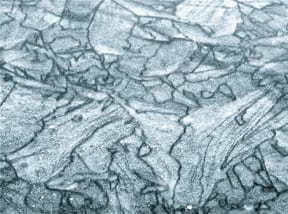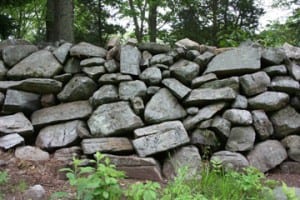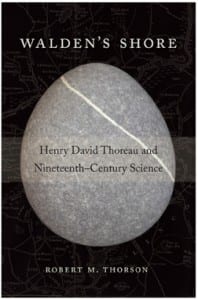BACKWARD GLANCE
I’m a card-carrying scientist. A physical scientist. Member #1897955 of the Geological Society of America. I received my card in 1973 as an eager undergraduate in looking forward to an exciting career. And I kept it valid through a Ph.D. program at the University of Washington and as a field geologist working for the U.S. Geological Survey before leaving Alaska for New England in 1984.

Heads this is physics; the brittle fracture of a thin sheet of ice under tension caused by waves passing underneath. Tails, this is art; an eye-grabbing, monochrome of order and chaos.
Four decades later, I find myself looking westward in memory and backwards in time over what has been—and continues to be—a rewarding science career. I know what it’s like to run a research lab, stuff it with graduate students, fund it with grants, and feed the corporate money machine of a modern research university.
I also know what it feels like to lose respect. Not from the undergraduates who garner the lion’s share of my attention, or from colleagues who know me well, but, from the ossified academic reward structure that guides the training, hiring, retention, promotion, and merit allocations at American research universities. The summit of this reward structure is research, which towers above the lower altitudes of teaching. Its continental divide is the separation of the sciences and the humanities, the Two Cultures highlighted by C.P. Snow. Based on my thirty-five years of professorial experience, this divide as strong as ever, notwithstanding the smoke and mirrors of administrative-speak.
I’ve seen this divide from near the top, having served several years on the promotion, tenure, and retention committee for my College of Liberal Arts and Sciences recruited by a dean in charge of twenty-three departments ranging from romance languages to physics. I’ve also seen it from the valley bottom of my own individual situation, having been discouraged by a reward structure that refuses to acknowledge that I’m a two-sided coin. Flip heads, and I’m a card-carrying physical scientist, someone whose dissertation was about the geophysical strain beneath the crust of Puget Sound. Flip tails and I’m a writer, an environmental journalist and a literary critic.
ACADEMIC REALITY

Archetype fieldstone wall in New England, this one from a roadside in Guilford, Connecticut. I’ve been obsessed with these objects since first seeing one in 1984.
My fall from ridge to ravine happened in September 2002. The warm-up was my learning Spanish by brute force in my mid-fifties for personal reasons, an ordeal that lit up the language side of my brain. The workout was my twelve-year ordeal of writing a twice-rejected book peripheral to my main academic job. The result was Stone by Stone: The Magnificent History in New England’s Stone Walls, a revisionist literary history told from the point of view of the soil. This perspective is pointed out by the preposition “in” rather than “of” in the title.
The hardcover sold so briskly—especially at indie bookstores—that it was reprinted before the paperback came out. Reviewers featured it. It earned the state’s highest award for non-fiction in 2003, bracketed by Michael Pollan’s Botany of Desire and Gus Speth’s Red Sky at Morning. I soon found myself coordinating a growing movement for landscape conservation through the Stone Wall Initiative. Then I hit the road as a stump evangelist for protecting stone walls, giving untold lectures and conducting field trips for public libraries, historical societies, conservation organisms, land trusts, and art museums. Next, I was a regular essayist for the Hartford Courant, the state’s major metropolitan daily. Next I was an environmental journalist under contract, writing a weekly opinion column, the first scientist to do so for the oldest continuously published paper in the United States. I had finally learned the true meaning of “publish or perish.”
During this rush of personal and professional growth, I let my grants run out and stopped cranking out proposals. Based on the bean-counting metrics of our Department of Geology & Geophysics, I was unproductive. Stone by Stone counted as the equivalent of one journal article because it wasn’t peer-reviewed by a cloister of specialists. My talks were marginalized with the condescending label “academic outreach.” My essays and columns were lumped as “miscellaneous other” publications, and scorned by some because they contained opinions, rather than evidence. When judged by an incentive structure pre-occupied with indirect cost recovery, journal rankings, and citation indices, I fell way below the bar.

Stratigraphic sequence of books that accumulated while compiling the bibliography for Beyond Walden (2009).
This pushed me over the ridge to the other side of the divide. There I discovered a welcoming and energized community of writers, literary scholars, historians, philosophers, poets, artists, archivists, architects, philanthropists, musicians, and independent scholars. Of course, I had known of these people before, but had never really knew them as professionals. Though I was initially a scientific fish out of water, I quickly evolved lungs to breathe new air. Presently, I’m a lungfish slithering back and forth across this great divide, mainly teaching on one side, and mainly doing scholarship on the other.
This divide between the sciences and the humanities didn’t exist for Henry D. Thoreau, the man who wrote: “Nothing is so truly bounded and obedient to law as music, yet nothing so surely breaks all petty and narrow bonds.” I discovered this quote while co-teaching an American Studies course with art, history, and English colleagues on Walden and the American Landscape. Gradually, I found myself slipping into the pond of Thoreau scholarship.
I spent the years 2006-2009 writing Beyond Walden my second book on “signature landforms,” this one about the tens of thousands of kettle lakes between Maine and Montana.
By 2010, the intellectual gravity of Walden Pond, the most famous kettle in the world, had pulled me under the water. Four years later, I emerged at Walden’s Shore, the title Harvard Press picked for my latest book about Thoreau enthusiastic and skillful plunge into physical science, one that informed his literary work. I argue that, seen from the lens of my training, Walden is more geocentric than it is anthrocentric or ecocentric, and more descendental than it is transcendental. So far, the reviewers haven’t pushed back too hard. A second book is underway.
PRACTICE MATTERS MORE
Though I’ve earned the merit badges of a discipline, I no longer define myself as a member of one, at least not exclusively. Instead I define myself by what I do in practice, rather than what I think about. This makes me a:
- Teacher whose primary focus has always been on undergraduate geoscience students, a for whom mentorship is a priceless opportunity to make a difference; a
- Scientist who still relishes field, laboratory, and quantitative research, publishes in specialized journals, and experiences sublimity from close encounters with material Nature through investigation; a
- Journalist who believes that individuals must take a stand for policies that are right for the planet, each in their own way. I choose writing on deadline, not because it’s easy, but because it’s easier for me than politics or committee work; an
- Author of books on what I call “signature landforms,” those that combine a geographic sense of place with a deep sense of time; and a
- Speaker to community groups, an effort beyond the condescending institutional speak of “academic outreach.”
FLUSHES vs. STRAIGHTS
In academia, we’re defined by the cards we hold in our hands. To enter the game, we must pick a suit—science, social science, humanities, art, medicine, law—and then play a specialty card within it, the higher its face value the better. The rules for retention, tenure, and promotion follow suit because they’re departmentalized by subject, a consequence of the belief that only close content-peers can discriminate quality. And as with the card game of poker, a low flush in one discipline always beats a high straight across the whole universe(ity) of knowledge and professional practice.
Before being fully promoted in 1996 I had no choice but to play by the rules, staying in suit with science while working towards a flush. I was OK with this, even if it rankled at times. Only later was I able to “come out” and be who I had been all along, someone who likes all of the cards in his hand, and is playing to share, rather than to win.
Since then, I’ve acquired some interesting cards. During the 2015 ASLE meeting, I plan to lay them out on the table for everyone to see. The ace I’ve held the longest is from the Geological Society of America. My newest ace is from the Association for the Study of Literature and Environment.
There you have it: my member perspective. Perhaps and perchance it can serve as an example for others climbing and backsliding the great divide.
ASLE Member Robert M. Thorson, Professor of Geology, Department of Ecology & Evolutionary Biology, Department of Anthropology, the Honors Program, and the Center for Integrated Geosciences, University of Connecticut

